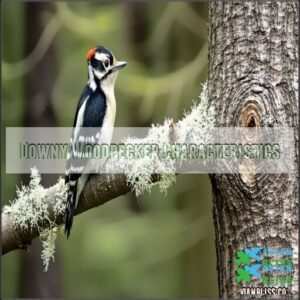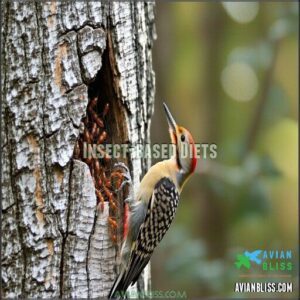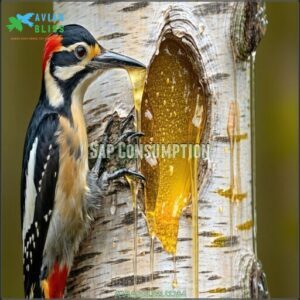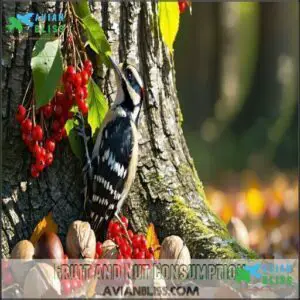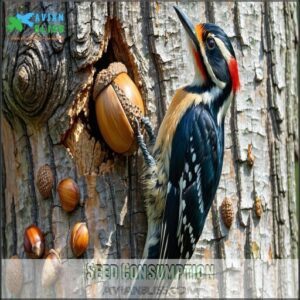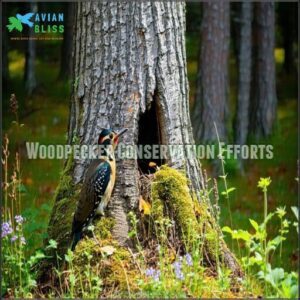This site is supported by our readers. We may earn a commission, at no cost to you, if you purchase through links.
 Oregon is home to 11 fascinating woodpecker species, each perfectly suited to the state’s mix of forests, mountains, and urban greenspaces.
Oregon is home to 11 fascinating woodpecker species, each perfectly suited to the state’s mix of forests, mountains, and urban greenspaces.
You’ll spot the small but spirited Downy Woodpecker hammering away on backyard trees or the striking Northern Flicker, often seen foraging on the ground.
The Red-breasted Sapsucker’s vibrant plumage adds a splash of color to Oregon’s woodlands, while Hairy Woodpeckers are often found probing bark for insects.
These birds play an essential ecological role, from controlling pests to creating nesting sites for other wildlife, and if you’re paying attention, their rhythmic tapping can reveal some surprising secrets of nature, highlighting the importance of woodlands and the need for ecological balance.
Table Of Contents
- Key Takeaways
- Woodpeckers in Oregon
- Types of Woodpeckers
- Woodpecker Diets and Foraging
- Woodpecker Behavior and Habitat
- Woodpecker Conservation Efforts
- Frequently Asked Questions (FAQs)
- What is the most common woodpecker in Oregon?
- Are woodpeckers good to have in your yard?
- What month are woodpeckers most active?
- What does it mean when a woodpecker is pecking on your house?
- Is it good to have woodpeckers in your yard?
- What is the difference between a red-headed woodpecker and a pileated woodpecker?
- How can you tell a sapsucker from a woodpecker?
- What does a woodpecker look like in Oregon?
- What kind of woodpecker is in Oregon?
- Why are woodpeckers pecking my house?
- Conclusion
Key Takeaways
- You’ll find 11 unique woodpecker species in Oregon, each thriving in varied habitats like forests, mountains, and urban areas.
- Woodpeckers play a crucial role in ecosystems by controlling pests, dispersing seeds, and creating nesting cavities for other wildlife.
- If woodpeckers peck your house, they’re likely looking for food, nesting spots, or marking territory—use deterrents to prevent damage.
- Protecting their natural habitats through sustainable forestry and conservation efforts ensures thriving woodpecker populations and ecological balance.
Woodpeckers in Oregon

You’ll find Oregon’s forests teeming with eleven distinct woodpecker species, from the tiny Downy Woodpecker to the impressive Pileated Woodpecker.
These remarkable birds contribute to forest health by controlling insect populations and creating nesting cavities that benefit countless other wildlife species, which is a key aspect of their role in maintaining ecological balance.
Woodpeckers shape forests by controlling pests and creating homes, keeping ecosystems balanced and thriving.
Overview of Woodpecker Species
Oregon’s diverse woodpecker species represent nature’s ultimate tree specialists.
Within the state’s forests, you’ll discover an incredible variety of these remarkable birds.
- The tiny Downy Woodpecker drums delicately on decayed wood
- Striking Red-breasted Sapsuckers create distinctive sap wells
- Massive Pileated Woodpeckers leave rectangular excavations
- Unique White-headed Woodpeckers rely heavily on ponderosa pine seeds
- Uncommon American Three-toed Woodpeckers thrive in beetle-infested areas
Oregon woodpeckers feature specialized adaptations for their ecological roles, making them a fascinating subject to study and observe in their natural habitat.
Woodpecker Habitats in Oregon
You’ll find woodpeckers in Oregon’s diverse habitats, including Coastal Forests, Cascade Mountains, and Ponderosa Pines, as well as Oak Woodlands and Urban Habitats, spanning various Oregon ecoregions and forest ecosystems.
Oregon’s woodpeckers thrive in diverse habitats, from lush coastal forests to vibrant urban woodlands, showcasing adaptability and ecological importance.
Several species, like the Hairy Woodpecker, thrive in mixed-conifer forests, which are a part of Oregon’s diverse habitats.
Woodpecker Conservation Status
Woodpecker conservation status in Oregon reflects a mix of progress and challenges.
While population trends improve for some, habitat fragmentation, invasive species, and climate impacts remain threats.
Conservation strategies focus on protection through sustainable forestry, preserving snags, and managing habitats.
Despite efforts, woodpecker threats highlight the need for continued conservation, ensuring these fascinating birds thrive in their essential ecosystems.
Types of Woodpeckers
In the context of woodpeckers in Oregon, you’ll find an incredible variety of species, each with unique traits that suit their habitats.
From the tiny Downy Woodpecker to the striking Northern Flicker, these birds play critical roles in forest health and biodiversity.
Downy Woodpecker Characteristics
The Downy Woodpecker, a tiny wonder among woodpecker species in Oregon, boasts striking black-and-white plumage details and a compact size for easy woodpecker identification.
With its short, chisel-like bill shape, this common woodpecker thrives in residential zones and forests.
Favoring slender branches and shrubs for foraging, its nesting habits involve tree cavities, making it a delight for birdwatchers across Oregon, with its ability to be a tiny wonder.
Hairy Woodpecker Characteristics
The Hairy Woodpecker stands out with its striking black-and-white plumage, a long, chisel-like bill, and bold drumming sounds.
Smaller than some woodpecker species but larger than the Downy, it prefers mixed forests, mature conifers, and hardwood habitats.
This Oregon species thrives on an insect-heavy diet while contributing to forest health.
Distinguishing it from similar species involves understanding beak size difference.
- Key Features: Black-and-white plumage, bold bill morphology
- Diet Specifics: Insects, spiders
- Habitat Preferences: Oregon’s mixed-conifer forests
Northern Flicker Characteristics
The Northern Flicker stands out among Oregon woodpeckers with its striking Flicker Plumage—boldly patterned underparts, a red nape patch, and a black bib.
Flicker Vocalizations are distinctive, often described as sharp, rhythmic calls.
This adaptable species thrives across Oregon, an expert in Flicker Identification.
Unlike most woodpecker species in Oregon, it often forages on the ground, showcasing remarkable Flicker Adaptations.
Red-breasted Sapsucker Characteristics
The Red-breasted Sapsucker is a stunning member of Oregon woodpeckers, found in coastal habitats.
Its sap specialization and brilliant red head make it easy to spot.
You’ll often recognize it by its distinctive vocalizations and these key traits:
- Bright red chest and head.
- Black-and-white patterned wings.
- Nesting habits favor decayed trees.
- Feeds on sap, insects, and fruits.
The combination of these characteristics, including its distinctive vocalizations, makes the Red-breasted Sapsucker a unique species.
Woodpecker Diets and Foraging
Woodpeckers in Oregon have a varied diet that includes insects, sap, fruits, seeds, and nuts, making them essential contributors to local ecosystems.
Their unique foraging methods, from drilling into tree bark for insects to lapping up sap with specialized tongues, highlight their adaptability and importance in maintaining forest health.
Insect-based Diets
While exploring Oregon, you’ll notice woodpeckers thrive on insects, showcasing fascinating insect foraging techniques.
Their diet includes larval consumption, spiders, and ants, adapting to seasonal insect availability.
They’re nature’s pest controllers, drilling into bark to uncover meals.
However, insecticide impact on their insect prey variety poses risks.
These expert insect hunters shape forest ecosystems with their precise woodpecker feeding habits.
| Insect Prey | Foraging Technique | Feeding Season | Threats |
|---|---|---|---|
| Larvae | Bark drilling | Year-round | Pesticides |
| Ants | Ground foraging | Spring-Summer | Habitat loss |
| Spiders | Perch maneuvering | Spring-Fall | Pollution |
| Beetles | Deep excavation | Summer-Fall | Climate change |
Sap Consumption
It’s fascinating how sap becomes a key part of the woodpecker diet.
Species like the red-naped, red-breasted, and Williamson’s sapsuckers use their specialized tongue adaptation to lap sap from precisely drilled holes.
Sap consumption benefits their energy needs with its nutritional value.
They time sap extraction to match sap flow seasonality, while trees evolve defenses to survive.
Fruit and Nut Consumption
A woodpecker’s diet in Oregon often includes fruits and nuts, providing essential nutritional value.
Their consumption patterns vary by seasonal availability, aligning with ripening local produce.
Here are key foraging habits:
- Pecking orchard fruits, interacting with trees.
- Stashing nuts during fall for winter.
- Aiding seed dispersal by snacking on berries.
These habits reflect a versatile, purposeful woodpecker diet, which is also essential for their survival.
Seed Consumption
If you thought fruit and nuts were fascinating, seeds are another staple in the woodpecker diet in Oregon.
Some species rely heavily on pine seeds, while others store acorns for winter. They also play a key role in seed dispersal, helping forests thrive.
One notable species is the acorn caching woodpecker, known for its unique storage behavior.
Here’s a quick breakdown:
| Woodpecker Species | Favorite Seeds | Foraging Habit |
|---|---|---|
| White-headed Woodpecker | Pine Seeds | Winter Seed Caches |
| Acorn Woodpecker | Acorns | Acorn Storage |
| Northern Flicker | Mixed Seeds | Opportunistic Eating |
Woodpecker Behavior and Habitat
You’ll find woodpeckers in Oregon inhabiting dense forests, open woodlands, and even urban areas, where their unique adaptations make them expert foragers and nest-builders.
They use their strong beaks and stiff tails to climb tree trunks, excavate nest cavities, and search for food, playing a key role in forest ecosystems, with their activities being an essential part of the environment, and their unique adaptations make them well-suited to their habitats.
Woodpeckers Pecking on Houses
If woodpeckers are targeting your Oregon home, they might be searching for insects, marking territory, or making nesting holes.
Identifying damage quickly is key—look for small, drilled holes in wood siding.
Damage prevention includes bird deterrents like nets, scarecrow tactics, or removing attractants like insects.
Consider using effective woodpecker deterrents to protect your property.
Legal protections mean harming woodpeckers is illegal, so repair options should comply with regulations.
Benefits of Having Woodpeckers
You mightn’t realize it, but woodpeckers are nature’s ultimate ecosystem engineers.
By controlling pests through insect control, they help maintain forest health.
Their cavity creation provides homes for other species, while seed dispersal promotes forest regeneration.
These actions keep ecosystems balanced and thriving, and their role in woodpecker ecology guarantees forests remain vibrant and full of life, which is crucial for maintaining forest health.
Woodpecker Nesting and Breeding
How do woodpeckers prepare for raising young? Their nesting and breeding habits are fascinating.
In Oregon, woodpeckers excel at cavity excavation, ensuring ideal nest sites.
Key details include:
- Clutch Size: Usually 4–8 eggs, depending on the species.
- Parental Care: Both parents share feeding duties.
- Fledgling Success: Young birds leave nests within 3–4 weeks.
- Nest Site Selection: Decayed trees and snags are preferred.
Pileated woodpeckers, for example, exhibit lifelong pair bonds.
Woodpecker Conservation Efforts
If you want to help Oregon’s woodpeckers, protecting their habitats is key, from preserving ancient forest snags to managing invasive species.
Conservation efforts like sustainable forestry and climate change mitigation are essential to support these birds and their critical role in ecosystems.
Habitat Preservation and Restoration
Preserving woodpecker habitats in Oregon starts with snag retention and invasive control.
Protecting decayed trees supports nesting and boosts biodiversity. Forest management practices, like creating climate resilience and expanding protected areas, guarantee thriving woodpecker habitats.
You can further improve the environment through dedicated habitat restoration.
Prioritizing woodpecker habitat restoration in Oregon forests preserves these species while balancing ecological needs—proving that every forest snag plays a pivotal role in conservation strategies, which is crucial for biodiversity.
Sustainable Forestry Practices
In Oregon forests, sustainable forestry means balancing timber needs with preserving woodpecker habitats.
Using selective logging and retaining snags guarantees nesting spots stay intact. Reforestation methods, like planting native trees, restore forest ecosystems.
Reduced impact practices protect forest health, while habitat corridors connect essential areas. These efforts help maintain thriving woodpecker populations and support the broader forest ecosystem.
South Carolina also implements conservation, including artificial nesting sites, to aid woodpecker populations, promoting biodiversity and ecosystem health.
Climate Change Mitigation
Tackling habitat loss demands action, especially with rising climate challenges.
Forest management aids resilience by reducing beetle infestations while fostering species adaptation to changing conditions.
Prioritize woodpecker conservation strategies like controlled burns and fire prevention, ensuring healthy forest ecosystems.
You can find Oregon conservation products to support these efforts.
These practices stabilize woodpecker population trends, safeguard bird conservation efforts, and protect essential habitats from climate-induced disruptions.
Let’s preserve thriving woodpecker habitats!
Rare and Uncommon Woodpeckers
Rare woodpeckers in Oregon, like the American three-toed and Lewis’s woodpeckers, are conservation priorities due to habitat loss and other challenges.
The White-headed woodpecker’s diet relies on ponderosa seeds, reflecting its specialized habitat needs. Monitoring populations guarantees sustainable management, protecting these species’ roles in ecosystems.
| Species | Habitat | Conservation Status | Unique Traits |
|---|---|---|---|
| American Three-toed | Higher-elevation forests | Strategy Species | Bark beetle reliance |
| Lewis’s Woodpecker | Ancient forests | Protected by Treaty Act | Elusive distribution |
| White-headed Woodpecker | Ponderosa pine forests | Sensitive in Oregon | Seed-focused diet |
| Williamson’s Sapsucker | Dead trees | Least Concern | Bright red throat and cap |
Frequently Asked Questions (FAQs)
What is the most common woodpecker in Oregon?
If you’ve ever played "spot the bird," the northern flicker is your MVP.
This charismatic woodpecker, found statewide, stands out with its spotted plumage and rhythmic drumming, thriving in diverse Oregon habitats.
Are woodpeckers good to have in your yard?
Woodpeckers are great to have in your yard.
They control pests by eating insects, create nesting cavities for other birds, and help trees by removing damage.
Just protect wooden siding to avoid potential pecking damage!
What month are woodpeckers most active?
Woodpeckers are most active during spring, especially April and May, when they’re busy nesting, drumming, and finding mates.
You’ll hear their rhythmic tapping, a mix of romance and renovation, echoing through wooded areas.
What does it mean when a woodpecker is pecking on your house?
When a woodpecker pecks your house, it’s likely looking for food, creating a nesting cavity, or marking territory.
They’re drawn to wood or surfaces resembling tree bark, especially with hidden insects or resonance.
Is it good to have woodpeckers in your yard?
Having woodpeckers in your yard is a good sign of a healthy ecosystem.
They control pests, create nesting cavities for other wildlife, and help maintain forest health.
Just protect your wooden structures from potential damage to ensure you can enjoy the benefits of having woodpeckers around, such as healthy ecosystem maintenance.
What is the difference between a red-headed woodpecker and a pileated woodpecker?
A red-headed woodpecker flaunts an all-red head, bold black wings with white patches, and prefers open woodlands.
The pileated woodpecker, larger, has a red crest, black body, white stripes, and loves dense, mature forests.
How can you tell a sapsucker from a woodpecker?
Spotting a sapsucker is easy if you notice their neat rows of tree holes for sap.
Unlike other woodpeckers, sapsuckers also lap sap with their tongues, while regular woodpeckers dig deeper for insects.
What does a woodpecker look like in Oregon?
You’ll often notice their vibrant patterns—like black-and-white stripes or bold red patches.
Oregon species show off unique looks, from the downy’s petite size to the sapsucker’s drilling style, blending into forests yet standing out brilliantly.
What kind of woodpecker is in Oregon?
You’ll find diverse woodpeckers in Oregon, including downy, hairy, and pileated species, alongside northern flickers and acorn woodpeckers.
Each thrives in specific habitats, from forests to suburban areas, playing essential roles in ecosystem health.
Why are woodpeckers pecking my house?
Imagine a tiny carpenter gone rogue—woodpeckers peck your house seeking insects, creating nesting cavities, or even marking territory.
Wooden sidings, dead trees, or soft spots mimic their natural habitat, attracting their relentless activity.
Conclusion
Just as woodpeckers carve niches in Oregon’s trees, they also shape its ecosystems.
These fascinating birds aren’t just beautiful—they’re essential to maintaining the state’s ecological balance by controlling pests, dispersing seeds, and creating habitats for other wildlife.
Whether you’re spotting a tiny Downy Woodpecker or the flashy Northern Flicker, the woodpeckers in Oregon showcase nature’s artistry and resilience.
By protecting their habitats and understanding their role, you play a part in preserving Oregon’s diverse natural heritage.

